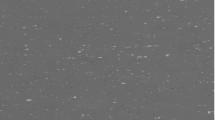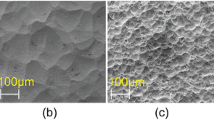Abstract
Statistical fractal characteristics are examined for polymer-based interfaces. Interfacial fracture behavior is modulated via exposure to varying levels of chemical contaminant concentration so as not to affect the initial interface roughness. The results of 1D height–height correlation analysis show a strong correlation between the interfacial fracture toughness and the resulting fracture surface roughness, and a toughness-independent roughness exponent; \(\beta \approx\) 0.35 ± 0.04, which is the slope of the self-affine domain. The cut-off length scale of the self-affinity is found to scale with interface toughness, and equal the combined length scales of interfacial cohesive length and plastic zone size within the adhesive layer. The reported statistical characteristics of interfacial fracture surfaces is among the first to show the quantitative inter-correlation between interfacial adhesion and the resulting fracture surface roughness. With additional examination of other systems, the observed correlations have the potential to assess the interfacial fracture toughness for a wide range of polymer-based interfaces.
Graphic abstract








Similar content being viewed by others
Data availability
The datasets generated during and/or analyzed during the current study are available from the corresponding author on reasonable request.
References
D. Hull, Fractography: Observing, Measuring and Interpreting Fracture Surface Topography (Cambridge University Press, Cambridge, 1999).
B.B. Mandelbrot, R. Pignoni, The Fractal Geometry of Nature, vol. 173 (WH freeman, New York, 1983).
B.B. Mandelbrot, D.E. Passoja, A.J. Paullay, Fractal character of fracture surfaces of metals. Nature 308, 721–722 (1984)
E.E. Underwood, K. Banerji, Fractals in fractography. Mater. Sci. Eng. 80(1), 1–14 (1986)
Z.Q. Mu, C.W. Lung, Studies on the fractal dimension and fracture toughness of steel. J. Phys. D 21(5), 848 (1988)
R.E. Williford, Multifractal fracture. Scr. Metall. 22(11), 1749–1754 (1988)
G.M. Lin, J.K.L. Lai, Fractal characterization of fracture surfaces in a resin-based composite. J. Mater. Sci. Lett. 12(7), 470–472 (1993)
C.S. Pande, L.E. Richards, N. Louat, B.D. Dempsey, A.J. Schwoeble, Fractal characterization of fractured surfaces. Acta Metall. 35(7), 1633–1637 (1987)
E. Bouchaud, G. Lapasset, J. Planes, Fractal dimension of fractured surfaces: a universal value? Europhys. Lett. 13, 73 (1990)
K.J. Maloy, A. Hansen, E.L. Hinrichsen, S. Roux, Experimental measurements of the roughness of brittle cracks. Phys. Rev. Lett. 68, 213 (1992)
J. Schmittbuhl, S. Gentier, S. Roux, Field measurements of the roughness of fault surfaces. Geophys. Res. Lett. 20(8), 639–641 (1993)
P. Daguier, B. Nghiem, E. Bouchaud, F. Creuzet, Pinning and depinning of crack fronts in heterogeneous materials. Phys. Rev. Lett. 78(6), 1062 (1997)
M.A. Issa, M.A. Issa, M.S. Islam, A. Chudnovsky, Fractal dimension––a measure of fracture roughness and toughness of concrete. Eng. Fract. Mech. 70(1), 125–137 (2003)
L. Ponson, A. Srivastava, S. Osovski, E. Bouchaud, V. Tvergaard, A. Needleman, Correlating toughness and roughness in ductile fracture. arXiv preprint arXiv:abs/1307.4413. (2013)
S. Santucci, K.J. Måløy, A. Delaplace, J. Mathiesen, A. Hansen, J.Ø.H. Bakke, J. Schmittbuhl, L. Vanel, P. Ray, Statistics of fracture surfaces. Phys. Rev. E 75(1), 016104 (2007)
L. Ponson, H. Auradou, P. Vié, J.P. Hulin, Low self-affine exponents of fractured glass ceramics surfaces. Phys. Rev. Lett. 97(12), 125501 (2006)
J.M. Boffa, C. Allain, J.P. Hulin, Experimental analysis of fracture rugosity in granular and compact rocks. Eur. Phys. J. 2(3), 281–289 (1998)
D. Bonamy, L. Ponson, S. Prades, E. Bouchaud, C. Guillot, Scaling exponents for fracture surfaces in homogeneous glass and glassy ceramics. Phys. Rev. Lett. 97(13), 135504 (2006)
S. Morel, D. Bonamy, L. Ponson, E. Bouchaud, Transient damage spreading and anomalous scaling in mortar crack surfaces. Phys. Rev. E 78(1), 016112 (2008)
E. Saborowski, P. Steinert, A. Dittes, T. Lindner, A. Schubert, T. Lampke, Introducing fractal dimension for interlaminar shear and tensile strength assessment of mechanically interlocked polymer-metal interfaces. Materials 13(9), 2171 (2020)
A.G. Evans, J.W. Hutchinson, Effects of non-planarity on the mixed mode fracture resistance of bimaterial interfaces. Acta Metall. 37(3), 909–916 (1989)
K.M. Liechti, Y.S. Chai, Asymmetric shielding in interfacial fracture under in-plane shear. J. Appl. Mech. 59(2), 295–304 (1992)
D. Yavas, X. Shang, W. Hong, A.F. Bastawros, Utilization of nanoindentation to examine bond line integrity in adhesively bonded composite structures. Int. J. Fract. 204(1), 101–112 (2016)
D. Yavas, A.F. Bastawros, Prediction of interfacial surface energy and effective fracture energy from contaminant concentration in polymer-based interfaces. ASME. J. Appl. Mech. 84(4), 044501 (2017)
D. Yavas, X. Shang, A.F. Bastawros, Mode-I fracture toughness and surface morphology evolution for contaminated adhesively bonded composite structures. Compos. Struct. 203, 513–522 (2018)
M. Lane, R.H. Dauskardt, A. Vainchtein, H. Gao, Plasticity contributions to interface adhesion in thin-film interconnect structures. J. Mater. Res. 15(12), 2758–2769 (2000)
H. Chai, On the correlation between the mode I fracture of adhesive joints and laminated composites. Eng. Fract. Mech. 24(3), 413–431 (1986)
H. Chai, Observation of deformation and damage at the tip of cracks in adhesive bonds loaded in shear and assessment of a criterion for fracture. Int. J. Fract. 60(4), 311–326 (1993)
D. Bonamy, E. Bouchaud, Failure of heterogeneous materials: a dynamic phase transition? Phys. Rep. 498(1), 1–44 (2011)
V. Tvergaard, J.W. Hutchinson, Toughness of an interface along a thin ductile layer joining elastic solids. Philos. Mag. A 70(4), 641–656 (1994)
A. Hillerborg, M. Modéer, P.E. Petersson, Analysis of crack formation and crack growth in concrete by means of fracture mechanics and finite elements. Cem. Concr. Res. 6(6), 773–781 (1976)
G. Bao, Z. Suo, Remarks on crack-bridging concepts. Appl. Mech. Rev. 45(8), 355–366 (1992)
I. Mohammed, K.M. Liechti, Cohesive zone modeling of crack nucleation at bimaterial corners. J. Mech. Phys. Solids 48(4), 735–764 (2000)
C. Wu, R. Huang, K.M. Liechti, Simultaneous extraction of tensile and shear interactions at interfaces. J. Mech. Phys. Solids 125, 225–254 (2019)
S. Jain, S.R. Na, K.M. Liechti, R.T. Bonnecaze, A cohesive zone model and scaling analysis for mixed-mode interfacial fracture. Int. J. Solids Struct. 129, 167–176 (2017)
MIL-STD-1246C, Product cleanliness levels and contamination control program (1994)
ASTM-D5528-13, Standard Test Method for Mode-I Interlaminar Fracture Toughness of Unidirectional Fiber-Reinforced Polymer Matrix Composites (ASTM International, West Conshohocken, 2013).
Acknowledgments
This work was supported by National Science Foundation under contract No. DMR-1807545, and by the Office of Naval Research (ONR) under Contract No. 104728. The authors would also like to acknowledge Redwood Scientific, Inc. on grades of contamination. Special thanks to an anonymous reviewer who has greatly helped in integrating the presentation of the paper.
Author information
Authors and Affiliations
Corresponding author
Ethics declarations
Conflict of interest
On behalf of all authors, the corresponding author states that there is no conflict of interest.
Rights and permissions
About this article
Cite this article
Yavas, D., Bastawros, A.F. Correlating interfacial fracture toughness to surface roughness in polymer-based interfaces. Journal of Materials Research 36, 2779–2791 (2021). https://doi.org/10.1557/s43578-021-00218-1
Received:
Accepted:
Published:
Issue Date:
DOI: https://doi.org/10.1557/s43578-021-00218-1




